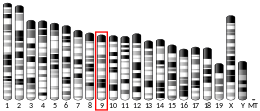Dock6
Dock6 (Dedicator of cytokinesis 6), also known as Zir1 is a large (~200 kDa) protein involved in intracellular signalling networks.[5] It is a member of the DOCK-C subfamily of the DOCK family of guanine nucleotide exchange factors which function as activators of small G proteins.
| DOCK6 | |||||||||||||||||||||||||
|---|---|---|---|---|---|---|---|---|---|---|---|---|---|---|---|---|---|---|---|---|---|---|---|---|---|
| Identifiers | |||||||||||||||||||||||||
| Aliases | DOCK6, AOS2, ZIR1, Dock6, dedicator of cytokinesis 6 | ||||||||||||||||||||||||
| External IDs | OMIM: 614194 MGI: 1914789 HomoloGene: 83291 GeneCards: DOCK6 | ||||||||||||||||||||||||
| |||||||||||||||||||||||||
| |||||||||||||||||||||||||
| |||||||||||||||||||||||||
| Orthologs | |||||||||||||||||||||||||
| Species | Human | Mouse | |||||||||||||||||||||||
| Entrez | |||||||||||||||||||||||||
| Ensembl | |||||||||||||||||||||||||
| UniProt | |||||||||||||||||||||||||
| RefSeq (mRNA) | |||||||||||||||||||||||||
| RefSeq (protein) | |||||||||||||||||||||||||
| Location (UCSC) | Chr 19: 11.2 – 11.26 Mb | Chr 9: 21.8 – 21.85 Mb | |||||||||||||||||||||||
| PubMed search | [3] | [4] | |||||||||||||||||||||||
| Wikidata | |||||||||||||||||||||||||
| |||||||||||||||||||||||||
Discovery
Dock6 was identified as one of a family of proteins which share high sequence similarity with Dock180, the archetypal member of the DOCK family.[6] It has a similar domain arrangement to other DOCK proteins,[7] with a DHR1 domain known in other proteins to bind phospholipids,[8] and a DHR2 domain containing the GEF activity.[9]
Function
There is currently very little information about the cellular role of this protein. However, Dock6 has been reported to exhibit dual GEF specificity towards the small G proteins Rac1 and Cdc42.[10] It is the only DOCK family member reported to activate both of these G proteins. The same study also showed that transfection of the Dock6 DHR2 domain into N1E-115 neuroblastoma cells promoted Rac- and Cdc42-dependent neurite outgrowth, although the physiological significance of this has yet to be demonstrated.
References
- GRCh38: Ensembl release 89: ENSG00000130158 - Ensembl, May 2017
- GRCm38: Ensembl release 89: ENSMUSG00000032198 - Ensembl, May 2017
- "Human PubMed Reference:". National Center for Biotechnology Information, U.S. National Library of Medicine.
- "Mouse PubMed Reference:". National Center for Biotechnology Information, U.S. National Library of Medicine.
- "Entrez gene: DOCK6 dedicator of cytokinesis 6".
- Côté JF, Vuori K (December 2002). "Identification of an evolutionarily conserved superfamily of DOCK180-related proteins with guanine nucleotide exchange activity". J. Cell Sci. 115 (Pt 24): 4901–13. doi:10.1242/jcs.00219. PMID 12432077.
- Meller N, Merlot S, Guda C (November 2005). "CZH proteins: a new family of Rho-GEFs". J. Cell Sci. 118 (Pt 21): 4937–46. doi:10.1242/jcs.02671. PMID 16254241.
- Côté JF, Motoyama AB, Bush JA, Vuori K (August 2005). "A novel and evolutionarily conserved PtdIns(3,4,5)P3-binding domain is necessary for DOCK180 signaling". Nat. Cell Biol. 7 (8): 797–807. doi:10.1038/ncb1280. PMC 1352170. PMID 16025104.
- Côté JF, Vuori K (2006). "In vitro guanine nucleotide exchange activity of DHR-2/DOCKER/CZH2 domains". Meth. Enzymol. 406: 41–57. doi:10.1016/S0076-6879(06)06004-6. PMID 16472648.
- Miyamoto Y, Yamauchi J, Sanbe A, Tanoue A (February 2007). "Dock6, a Dock-C subfamily guanine nucleotide exchanger, has the dual specificity for Rac1 and Cdc42 and regulates neurite outgrowth". Exp. Cell Res. 313 (4): 791–804. doi:10.1016/j.yexcr.2006.11.017. PMID 17196961.
Further reading
- Côté JF, Vuori K (2007). "GEF what? Dock180 and related proteins help Rac to polarize cells in new ways". Trends Cell Biol. 17 (8): 383–93. doi:10.1016/j.tcb.2007.05.001. PMC 2887429. PMID 17765544.
- Kwofie MA, Skowronski J (2008). "Specific recognition of Rac2 and Cdc42 by DOCK2 and DOCK9 guanine nucleotide exchange factors". J. Biol. Chem. 283 (6): 3088–96. doi:10.1074/jbc.M705170200. PMID 18056264.
- Katoh H, Negishi M (2003). "RhoG activates Rac1 by direct interaction with the Dock180-binding protein Elmo". Nature. 424 (6947): 461–64. doi:10.1038/nature01817. PMID 12879077.



